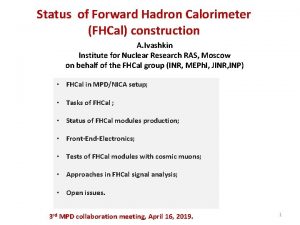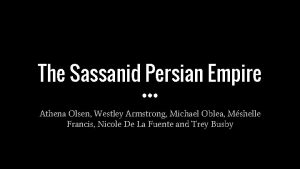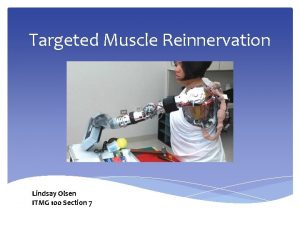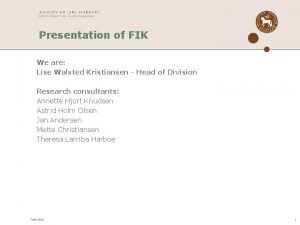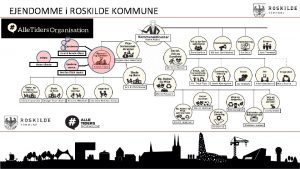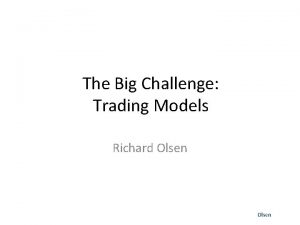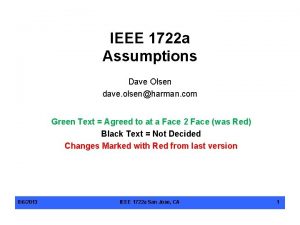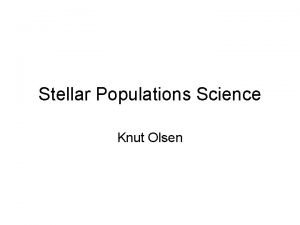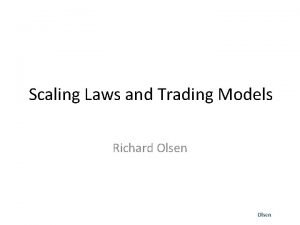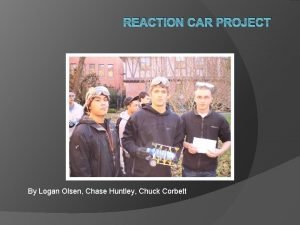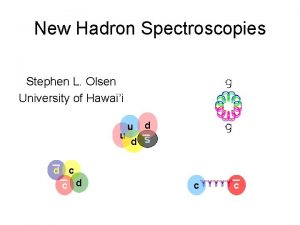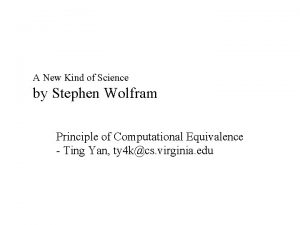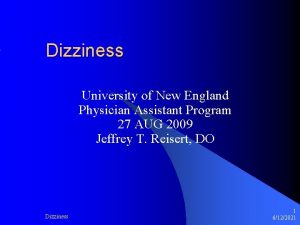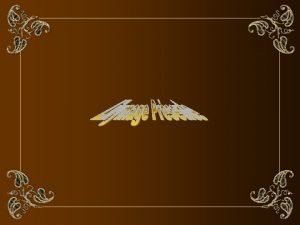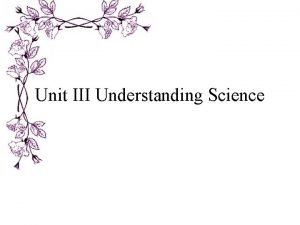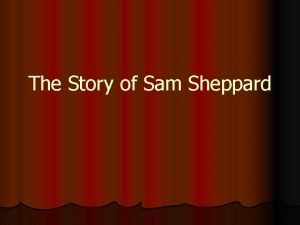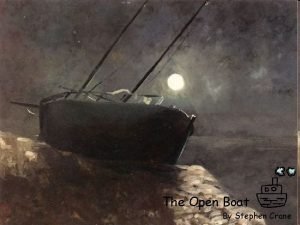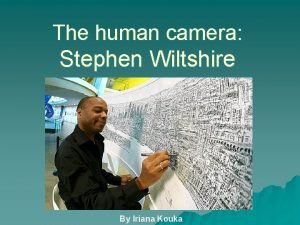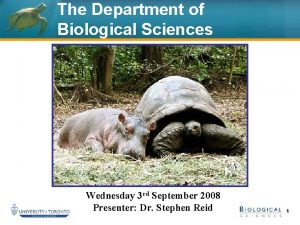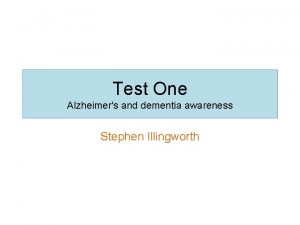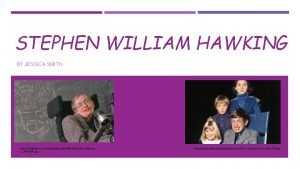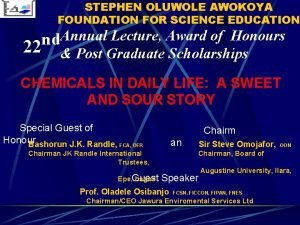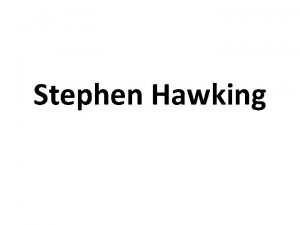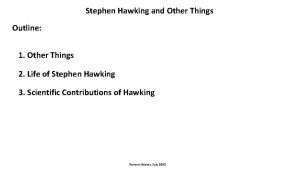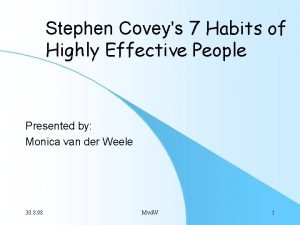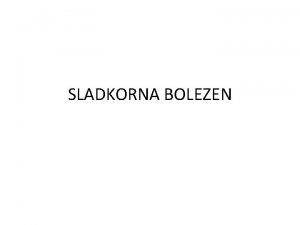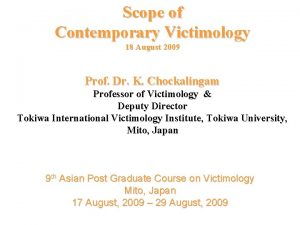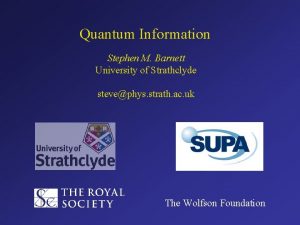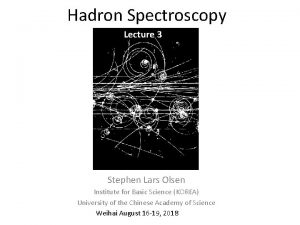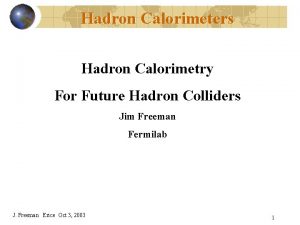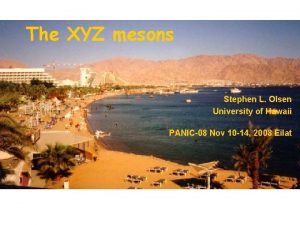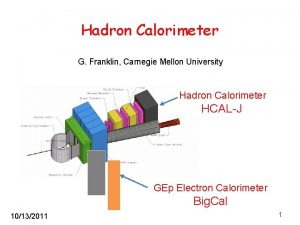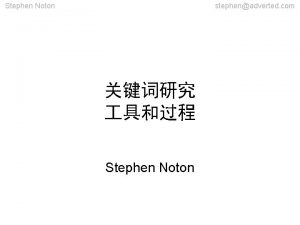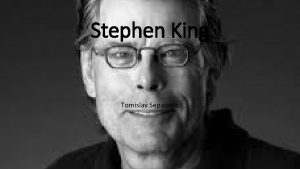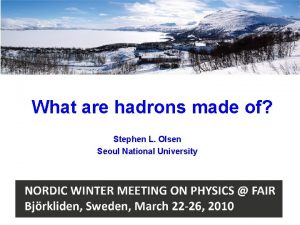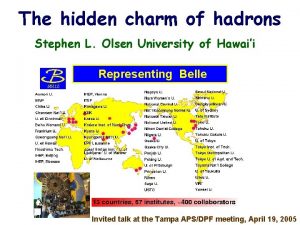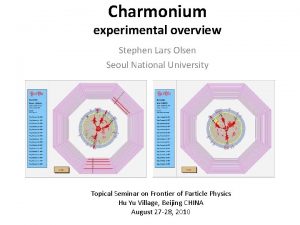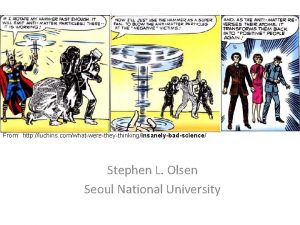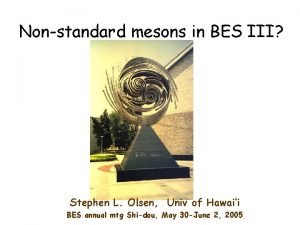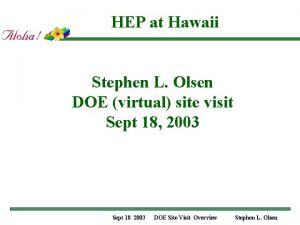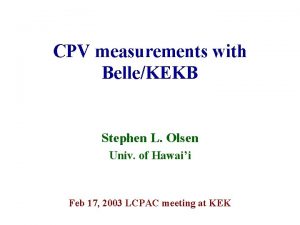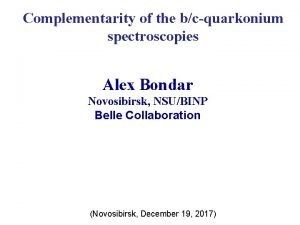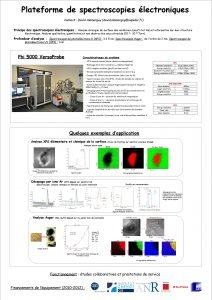New Hadron Spectroscopies Stephen L Olsen University of












































































- Slides: 76

New Hadron Spectroscopies Stephen L. Olsen University of Hawai’i u d s d c c

History: 1930’s: proton & neutron. . all we need? ? ? chadwick 1950’s: , , , … “Had I foreseen that, I would have gone into botany” – Fermi 1960’s: The 8 -fold way “ 3 quarks for Mister Mark” Gell-Mann 1970’s add charmed particles 1980’s & beauty Richter Ting Lederman 1990’s & (finally? ) top Peters Jones

Hadron “zoo” mesons baryons

Quarks restore economy (& rescue future Fermis from Botany? ) 3 quarks u+2/3 M. Gell-Mann d-1/3 u-2/3 s-1/3 Baryons: qqq p: p: u+2/3 d-1/3 u-2/3 d+1/3 (& 3 antiquarks) d+1/3 s+1/3 Mesons: q q +: u+2/3 d+1//3 -: u-2/3 u+2/3

Fabulously successful, but… • quarks are not seen • why only qqq and qq combinations? • What about spin-statistics?

W- s-1/3 2 of these s-quarks are in the same quantum state Das ist verboten!!

The strong interaction “charge” of each quark comes in 3 different varieties Y. Nambu O. Greenberg Ws-1/3 the 3 s-1/3 quarks in the W- have different color charges & evade Pauli

QCD: Gauge theory for color charges Nambu Gell-Mann & Fritzsch generalization of QED scalar charge: e QCD isovector charge: QED gauge Xform +ie. A 1 vector field (photon) er eb eg QCD gauge Xform + i a li Gi eight 3 x 3 SU(3) matrices 8 vector fields (gluons)

Attractive configurations eijk eiejek i≠ j≠k dij ei ej same as the rules for combing colors to get white: 3 different primary colors color-complementary color eiejek color charges Hence the name: Quantum Chromodynamics

Difference between QED & QCD QED: photons have no charge QCD: gluons carry color charges gluons interact with each other

Vacuum polarization QED vs QCD 2 nf 11 CA in QCD: CA=3, & this dominates

QED QCD difference Coupling strength a distance

Testing the Standard Model QCD X decrease in aswith distance Electro-Weak W, Z & t masses Z width sin 2 q. W Asymmetries Cross-sections … X QED Lamb-shift g-2 Atomic spectra …

Tests of QED and EW sectors QED (tested @ ppb) Example: (g-2)/2|electron Expt: 1, 159, 652, 188. 4(4. 3)x 10 -12 Theory: 1, 159, 652, 201. 4(28)x 10 -12 Electro-Weak sector (tested @ ~0. 01% level)

Test QCD with 3 -jet events (& deep inelastic scattering) as gluon rate for 3 -jet events should decrease with Ecm

“running” as Why are these people smiling?

Probe QCD from other directions non-qq or non-qqq hadron spectroscopies: Pentaquarks: e. g. an S=+1 baryon u d s (only anti-s quark has S=+1) Glueballs: gluon-gluon color singlet states Multi-quark mesons: qq-gluon hybrid mesons d c c

Pentaquarks “Seen” in many experiments but not seen in just as many others Belle BES Ba. Bar CDF High interest: 1 st pentaquark paper has ~500 citations

Experimental situation is messy (many contradictory results) NA 49 pp @ Ecm=17 Ge. V (fixed tgt) (PRL 92, 052301: 237+ citations!) (1862): qqssd 1862 ± 2 Me. V FWHM = 17 Me. V = 5. 6 COMPASS mp @ Em =160 Ge. V (fixed tgt) 100 s of (1530)s but no hint of (1862) hep-ex/0503033

Pentaquark Scoreboard Positive signals Negative results Also: Belle Compass L 3 Yes: 17 No: 17

Existence of Pentaquarks is not yet established

multi-quark mesons? B K + -J/y y’ + -J/y X(3872) M( J/y)

Seen in 4 experiments CDF X(3872) D 0 X(3872)

Is the X(3872) a cc meson? Could it be one of these? 3872 Me. V These states are already identified

no cc state fits well 3872 hc ” M too low and G too small hc ’ angular dist’n rules out 1+- cc 1’ G( J/y) way too small y 2 G( cc 1) too small; M( + -) wrong hc 2 y 3 hc should dominate G( cc 2 & DD) too small SLO hep-ex/0407033

back to square 1 Determine PC J quantum numbers of the X(3872)

PC J Possible values -0 -+ 0 +0 exotic violates parity (hc”) DD allowed exotic DD allowed 1 -+ 1 +1 DD allowed (y(3 S)) exotic DD allowed (cc 1’) (hc’) 2 ++ 2 +2 (y 2) (hc 2) DD allowed exotic DD allowed (for J ≤ 2) (cc 0’) (cc 2’)

Possible 0 -- exotic violates parity PC J values -+ 0 0++ 0+- DD allowed exotic DD allowed (hc”) (for J ≤ 2) (cc 0’) 1 - - 1 -+ DD allowed (y(3 S)) exotic DD allowed 2 + 2 (y 2) (hc 2) (cc 2’) ++ 1 +1 (cc 1’) (hc’) 2++ 2+- DD allowed exotic DD allowed

Use 250 fb-1 ~275 M BB prs X(3872) + -J/y y’ + -J/y Signal (47 ev) Sidebands (114/10 = 11. 4 ev)

Areas of investigation • Search for radiative decays • Angular correlations in X J/y decays • Fits to the M( ) distribution • Search for X(3872) D*0 D 0

Search for X(3872) J/y

Kinematic variables B B K + -J/y e+ e- B Ecm/2 ϒ(4 S) Ecm/2 DE CM energy difference: B K + -J/y Beam-constrained mass: Mbc

Select B K J/y B Kcc 1; cc 1 J/y X(3872)? M( J/y) 13. 6 ± 4. 4 X(3872) J/y evts (>5 significance) Mbc Bf(X J/y) Bf(X J/y) Mbc =0. 14 ± 0. 05

Evidence for X(3872) + - 0 J/y (reported last summer hep-ex/0408116) 12. 4 ± 4. 2 evts B-meson yields vs M( + - 0) Br(B 3 J/y) Br(B 2 J/y) = 1. 0 ± 0. 5 Large (near max) Isospin violation!!

Evidence for C=+1 is overwhelming • B J/y only allowed for C=+1 • same for B ”w”J/y (reported earlier) • M( ) for X + -J/y looks like a

Possible JPC values (C=-1 ruled out) 0 -- exotic violates parity 1 - - DD allowed (y(3 S)) 2 - (y 2) -+ 0 (hc”) 1 -+ exotic DD allowed 0++ DD allowed (cc 0’) ++ 1 (cc 1’) 2++ + 2 DD allowed (hc 2) (cc 2’) 0+- exotic DD allowed 1+- (hc’) 2+- exotic DD allowed

Angular Correlations Jz=0 X 3872 J=0 K J/y

Strategy: for each JPC, find a distrib 0 if we see any events there, we can rule it out Rosner (PRD 70 094023) Bugg (PRD 71 016006)

0 -+ : sin 2 q sin 2 y c 2/dof=18/9 q |cosq| c 2/dof=34/9 y safe to rule out 0 -+ |cosy|

0++ ql In the limit where X(3872), , & J/y rest frames coincide: d. G/dcosql sin 2 ql c 2/dof = 41/9 rule out 0++ |cosql |

++ 1 1++: sin 2 ql sin 2 c compute angles in X(3872) restframe c 2/dof = 11/9 ql K c 1++ looks okay! |cosql| c 2/dof = 5/9 |cosc|

Possible JPC values (0 -+ & 0++ ruled out) 0 -- exotic violates parity 0 -+ 0++ (hc”) DD allowed 1 - - 1 -+ DD allowed (y(3 S)) 2 - (y 2) exotic DD allowed (cc 0’) ++ 1 (cc 1’) 2++ + 2 DD allowed (hc 2) (cc 2’) 0+- exotic DD allowed 1+- (hc’) 2+- exotic DD allowed

Fits to the M( ) Distribution J/y X q* q* X J/y in P-wave has a q*3 centrifugal barrier

M( ) can distinguish -J/y S- & P-waves S-wave: c 2/dof = 43/39 (CL= 28%) P-wave: c 2/dof = 71/39 (CL=0. 1%) q* roll-off Shape of M( ) distribution near the kinematic limit favors S-wave q*3 roll-off

Possible JPC values (J-+ ruled out) 0 -- exotic violates parity 0 -+ 0++ (hc”) DD allowed 1 - - 1 -+ DD allowed (y(3 S)) exotic DD allowed 2 - (y 2) 2 - + (hc 2) (cc 0’) ++ 1 (cc 1’) 2++ DD allowed (cc 2’) 0+- exotic DD allowed 1+- (hc’) 2+- exotic DD allowed

Search for 0 0 0 X D D

Select 0 0 0 B D D events D*0 D 0 0? y r a n 22± 7 signal evts i m i l e r Bf(B KX)Bf(X D*D)=2. 2± 0. 7± 0. 4 x 10 P |DE| -4 |DE|

X DD rules out 2++ • 1++ : DD* in an S-wave q* • 2++ : DD* (or DD ) in a D-wave q*5 Strong threshold suppression

Possible JPC values (2++ ruled out) 0 -- 0+- exotic violates parity 0 -+ 0++ (hc”) DD allowed 1 - - 1 -+ DD allowed (y(3 S)) exotic DD allowed ++ 1 (hc’) 2 - (y 2) 2 - + (hc 2) 2++ 2+- DD allowed exotic DD allowed (cc 0’) ++ 1 (cc 1’) (cc 2’) exotic DD allowed 1+-

a 1++ cc state? • 1++ cc 1’ – Mass is off – cc 1’ r J/y violates Isospin, should be suppressed. 3872 G(X J/y)/G(X J/y) Theory: Expt: ~ 30 0. 14 ± 0. 05 cc 1’ component of the X(3872) is ≤ few %

Intriguing fact MX 3872 =3872 ± 0. 6 ± 0. 5 Me. V m. D 0 + m D 0* = 3871. 2 ± 1. 0 Me. V lowest mass charmed meson lowest mass spin=1 charmed meson X(3872) is very near DD* threshold. is it somehow related to that?

hh bound states (hadronium)? There is lots of literature about this possibility deuteron: Hadronium attractive nuclear force p n loosely bound 3 -q color singlets with Md = mp+mn- e N. Tornqvist hep-ph/0308277 (dueson): attractive force? ? D D* loosely bound q-q color singlets with M = m. D + m. D* - d

X(3872) = D 0 D*0 bound state? • JPC = 1++ is favored • M≈m. D 0 + m. D 0* Tornqvist PLB 590, 209 (2004) Swanson PLB 588, 189 (2004) • Maximal Isospin violation is natural: |I=1; Iz= 0> =1/ 2(|D+D*->+ |D 0 D*0>) |I=0; Iz= 0> =1/ 2(|D+D*-> - |D 0 D*0>) |D 0 D*0> = 1/ 2( |10> - |00>) Equal mixture of I=1 & I =0 • G(X J/y) < G(X J/y) is expected Swanson PLB 598, 197 (2004)

X(3872) conclusion • Not a cc state CC • Most likely a D 0 D*0 bound state d c c d 1 st well established tetraquark

Are there others? Look at other B decays hadrons+J/y B K h J/y B K w J/y B K …

B K w. J/y in Belle “Y(3940)” M≈3940 ± 11 Me. V G≈ 92 ± 24 Me. V

Y(3940): What is it? • Charmonium? – Conventional wisdom: w. J/y should not be a discovery mode for a cc state with mass above DD & DD* threshold! • Some kind of w-J/y threshold interaction? – the J/y is not surrounded by brown muck; can it act like an ordinary hadron? J/y w

Y(3940): What is it? (continued) • another tetraquark? – M ≈ 2 m. Ds – not seen in Y h. J/y • (h contains ss) ? ? PRL 93, 041801 M(h J/y) – width too large? ? – need to search for Y(3949) DSDS c s

Y(3940): What is it? (continued) • cc-gluon hybrid? – – predicted by lattice QCD, decays to DD and DD* are suppressed large hadron+J/y widths are predicted masses expected to be 4. 3 ~ 4. 4 Ge. V (higher than what we see) c c

Summary • X(3872): d c PC ++ – J established as 1 d c – cc component is small (≤ few %) – all measured properties are consistent with a D 0 D*0 bound state 1 st established tetraquark! • Y(3940): – No obvious cc assignment – tetraquark seems unlikely – cc-gluon hybrid? – Lots to do: c c • determine JPC • search for other decay channels (DD*, Ds. Ds, …)

Other hadronium states? fitted peak location J/y pp in the BES expt J. Z. Bai PRL 91, 022001(2003) +3 +5 M=1859 -10 -25 Me. V/c 2 G < 30 Me. V/c 2 (90% CL) c 2/dof=56/56 0 0. 1 0. 2 M(pp)-2 mp (Ge. V) 0. 3 acceptance

The case of the mystery meson Stephen L. Olsen University of Hawai’i

SU(3) octets baryons & decuplets S>0 Meson octets S<0

Hence the name: Quantum Chromo Dynamics q q q

confinement

Grand Unification? QED EW s

“Data, I need data. I can’t make bricks without clay” 1 fb -1/day 10 34

Strategy: for each JPC, find a distrib 0 if we see any events there, we can rule it out Ex: 1 --: sin 2 q Km y’ is 1 -- Use y’ to check accept. y’: c 2/dof = 8. 9/9 q m K ompute angles in J/y restframe D. V. Bugg hep-ph/0410168 v 2

|cosq. Kl| for X(3872) events fit with sin 2 q. Kl + bkgd c 2/dof = 45/9 see 8 evts/bin expect 2~3 evts/bin X(3872) is not 1 -- ! background scaled from sidebands

1+- and 2 -use J/y helicity angle q. J/y X For the y’ + -J/y, this should be ~flat K q. J/y |cosq. J/y|

1+- and 2 -1+-: sin 2 q c 2/dof=32/9 |cosq. J/y| J/y 2 --: sin 2 q. J/y cos 2 q. J/y c 2/dof=20/9 |cosq. J/y| can rule out 1+- (Cl < 0. 1%)

Narrow multi-quark mesons? • Ds. J(2317) & Ds. J(2457) CLEO M(Ds ) M(Ds* ) • X(3872) J/y M( J/y)

What are the Ds. J states? Belle found B D Ds. J(2317) D Ds. J(2457) and Ds. J(2457) Ds

Angular analysis for B D Ds. J Dsp(g) J=0 z Jz=0 Ds. J(2317) Ds 0 ( ) Ds. J(2460) Ds J=1 Ds. J(2317) = 0+ Ds. J(2547) = 1+ J=0 J=2

Ds. J fit into cs spectrum (with a mass shift) Ds. J(2547) = 1+ Ds. J(2317) = 0+

Ds. J states are likely ordinary L=1 cs mesons Theory got the masses wrong
 Hadron calorimeter
Hadron calorimeter Hadron collider
Hadron collider Hadron collider
Hadron collider Lhc tantalizing new physics
Lhc tantalizing new physics Hadron
Hadron Athena olsen
Athena olsen Lindsay olsen singer
Lindsay olsen singer Annette hjort olsen
Annette hjort olsen Sassi uthsc
Sassi uthsc Tagudskiftning roskilde
Tagudskiftning roskilde Oanda corporation richard olsen
Oanda corporation richard olsen Marie bendix olsen
Marie bendix olsen Tava olsen
Tava olsen Ieee 1722
Ieee 1722 Riley olsen
Riley olsen Brigitta olsen
Brigitta olsen Kristbjörg heiður olsen
Kristbjörg heiður olsen Dylan knut olsen bokvist
Dylan knut olsen bokvist Olsen scale forex
Olsen scale forex Mentln
Mentln Tillie olsen i stand here ironing full text
Tillie olsen i stand here ironing full text Logan olsen
Logan olsen Victoria olsen
Victoria olsen Olsen palermo
Olsen palermo Karen holm olsen
Karen holm olsen Olsen palermo
Olsen palermo Stephen wolfram a new kind of science
Stephen wolfram a new kind of science 詹景裕
詹景裕 Buckinghamshire new university ranking
Buckinghamshire new university ranking University of new england
University of new england University of new england physician assistant program
University of new england physician assistant program University of new mexico internal medicine residency
University of new mexico internal medicine residency New speaker new line worksheet
New speaker new line worksheet New york pennsylvania new jersey delaware
New york pennsylvania new jersey delaware Fresh oil new wine
Fresh oil new wine Marquis theatre
Marquis theatre Strengths and weaknesses of the articles of confederation
Strengths and weaknesses of the articles of confederation New-old approach to creating new ventures
New-old approach to creating new ventures New marketing realities pdf
New marketing realities pdf New years old is new again
New years old is new again New classical macroeconomics
New classical macroeconomics Chapter 16 toward a new heaven and a new earth
Chapter 16 toward a new heaven and a new earth Neil thisse is a loyalist answers
Neil thisse is a loyalist answers New classical and new keynesian macroeconomics
New classical and new keynesian macroeconomics New nationalism vs new freedom venn diagram
New nationalism vs new freedom venn diagram Stephen kumalo character traits
Stephen kumalo character traits Stephen poplawski
Stephen poplawski Stephen hawking
Stephen hawking Sam sheppard wrestling
Sam sheppard wrestling Stephen ngan
Stephen ngan The open boat stephen crane summary
The open boat stephen crane summary Human camera stephen wiltshire
Human camera stephen wiltshire Stephen reid utsc
Stephen reid utsc Habit 8 find your voice
Habit 8 find your voice Emotional bank account 7 habits
Emotional bank account 7 habits Stephen illingworth
Stephen illingworth Strawberry spring characters
Strawberry spring characters Stephen hawking william smith
Stephen hawking william smith Stephen oluwole awokoya foundation for science education
Stephen oluwole awokoya foundation for science education Stephen king monash
Stephen king monash Stephen hawking cbe
Stephen hawking cbe Stephen hawking
Stephen hawking Hawking
Hawking Habit 3 of 7 habits
Habit 3 of 7 habits Stephen hawking bolezen
Stephen hawking bolezen Inside out approach 7 habits
Inside out approach 7 habits Types of victims according to mendelsohn
Types of victims according to mendelsohn Server-sent events scalability
Server-sent events scalability Stephen graham description bubble
Stephen graham description bubble Quantum information stephen m. barnett
Quantum information stephen m. barnett Personal monologue examples
Personal monologue examples Concept of ob
Concept of ob Stephen curto
Stephen curto Stephen daze
Stephen daze Management by stephen p robbins 9th edition
Management by stephen p robbins 9th edition Stephen ridella
Stephen ridella Poem my parents
Poem my parents
